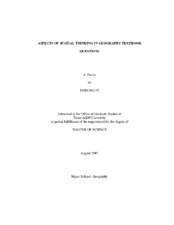| dc.description.abstract | This study examined questions embedded in four high school world geography textbooks to evaluate the degree to which the three components of spatial thinking were incorporated: concepts of space, tools of representation, and processes of reasoning. A three-dimensional taxonomy of spatial thinking to assess the questions was developed and validated via a survey of a group of spatial thinking experts. The spatiality of the concepts featured in 3,010 questions sampled from the textbooks was analyzed. The degree to which spatial representations and stimuli for reasoning were presented was also measured. Every question was compared against the taxonomy and coded. Inter-coder reliability was measured on about one percent of the sample questions. The results indicated that most questions that required knowledge about spatial concepts could be answered by knowing only simple concepts, such as location and place-specific identity, rather than complex concepts that require the identification of spatial patterns and associations. Not many questions asked students to incorporate spatial representations to answer the questions. Few questions did require creating a new representation. Students were asked to recall memorized geographic knowledge and terms rather than to infer, hypothesize, and generalize. Little difference was found among the four textbooks in that they rarely integrated the three components of spatial thinking into the questions. The research found that page-margin questions involved aspects of spatial thinking more than section- and chapter-assessment questions. Relatively simple concepts and lower level cognitive processes, however, were required in most questions that integrated the three components. The development of questions to help students practice complex processes of spatial thinking is necessary. The taxonomy developed in this research can be used as a guide to design curricular, instructional materials, and questions that incorporate aspects of spatial thinking. | en |


